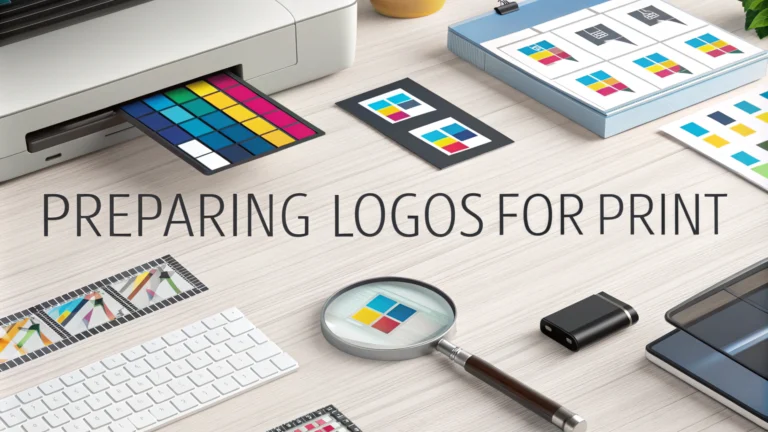Preparing a logo for print requires specific technical knowledge to ensure the final product looks crisp and professional across different printing methods.
A properly prepared print logo should be created in vector format using software like Adobe Illustrator to maintain quality at any size.
Essential File Formats for Print Logos
- AI (Adobe Illustrator) – Native vector format
- EPS – Industry standard for print shops
- PDF – Universal format that preserves vector data
- SVG – Scalable format useful for both print and web
Technical Specifications
- Resolution: 300 DPI minimum for raster elements
- Color Mode: CMYK for print (not RGB)
- Bleed: Add 1/8 inch (0.125″) when required
- Convert text to outlines/paths
Black elements should be set to 100% K (pure black) rather than a mix of CMYK values for cleaner printing.
Size Considerations
- Minimum size: Test logo at smallest intended print size
- Maximum size: Ensure vectors are clean for large formats
- Multiple versions: Create variations for different size needs
Common Print Methods & Requirements
| Print Method | Special Requirements |
|---|---|
| Offset Printing | CMYK, vector format |
| Screen Printing | Separated colors, simplified design |
| Embroidery | Simplified paths, minimum 2mm thick lines |
Quality Control Checklist
- Check for stray points and unnecessary anchors
- Ensure all colors are in CMYK mode
- Verify font outlines are converted
- Test print at various sizes
- Include printer marks when needed
Always package your files with linked images and used fonts when sending to print vendors.
File Organization Tips
- Name files clearly with version numbers
- Include color variations (CMYK, spot colors, black & white)
- Save different size versions in separate files
- Keep original master file separate from production versions
For specialized printing techniques like foil stamping or embossing, consult with your printer about specific file preparation requirements.
Request a proof before final printing to verify colors and quality match expectations.
Color Management
- Use Pantone colors when brand consistency is crucial
- Create color libraries for brand standards
- Document color values for all variations
- Include spot color versions when needed
Pre-press Considerations
- Check overprint settings
- Verify transparency flattening
- Review layer organization
- Ensure proper trapping settings
File Delivery Best Practices
- Include readme file with specifications
- Compress files appropriately
- Provide both high-res and low-res versions
- Include color swatches and guidelines
Final Steps Before Print
Run preflight checks to catch potential issues before sending files to the printer. Create detailed documentation of all logo versions and their intended uses. Maintain organized archives of all final files and variations.
Conclusion
Successful logo printing requires attention to technical details and proper file preparation. Following these guidelines ensures consistent, high-quality results across different printing methods and applications. Regular communication with print vendors and thorough quality control checks are essential for achieving professional outcomes. Keep master files well-organized and documented for future use and modifications.
FAQs
- What file format should I use when preparing my logo for print?
Vector formats like AI, EPS, or PDF are ideal for print as they maintain quality at any size. For best results, convert all text to outlines. - What color mode should my logo be in for printing?
Use CMYK color mode for print materials. RGB files need to be converted to CMYK as they’re designed for screen display, not printing. - What resolution should my logo have for print?
If using raster formats, minimum 300 DPI for standard printing. For large format printing, higher resolutions might be needed based on viewing distance. - Should I include bleed in my logo files for print?
Add 0.125 inches (3mm) bleed on all sides when the logo extends to the edge of printed materials to avoid unwanted white edges after trimming. - How do I ensure my black prints correctly?
For rich black, use C:30 M:30 Y:30 K:100. For small text or thin lines, use 100% K only to avoid registration issues. - What’s the minimum size my logo should be printed at?
Test print at intended size to ensure legibility. Generally, logos shouldn’t be printed smaller than 0.5 inches in height for complex designs. - How do I prepare metallic or spot colors for printing?
Define specific Pantone colors in your file and communicate with your printer about special inks. Convert to CMYK if spot colors aren’t being used. - What should I check before sending my logo to print?
Verify all text is converted to outlines, colors are in CMYK, appropriate resolution is set, and proper bleed is included if needed. - How should I handle gradient printing in logos?
Keep gradients above 10% of the lightest color to ensure smooth printing. Avoid gradients that fade to 0% as they may print inconsistently. - What file versions should I provide to the printer?
Supply both vector (AI, EPS, or PDF) and high-resolution raster (TIFF, PNG) versions. Include both color and black/white versions of the logo.







